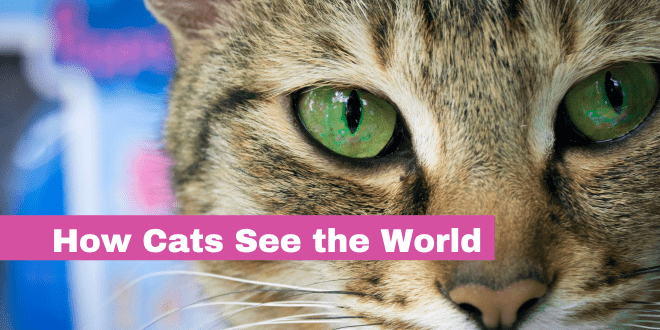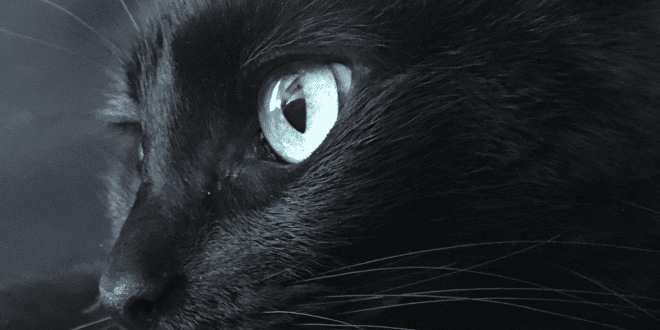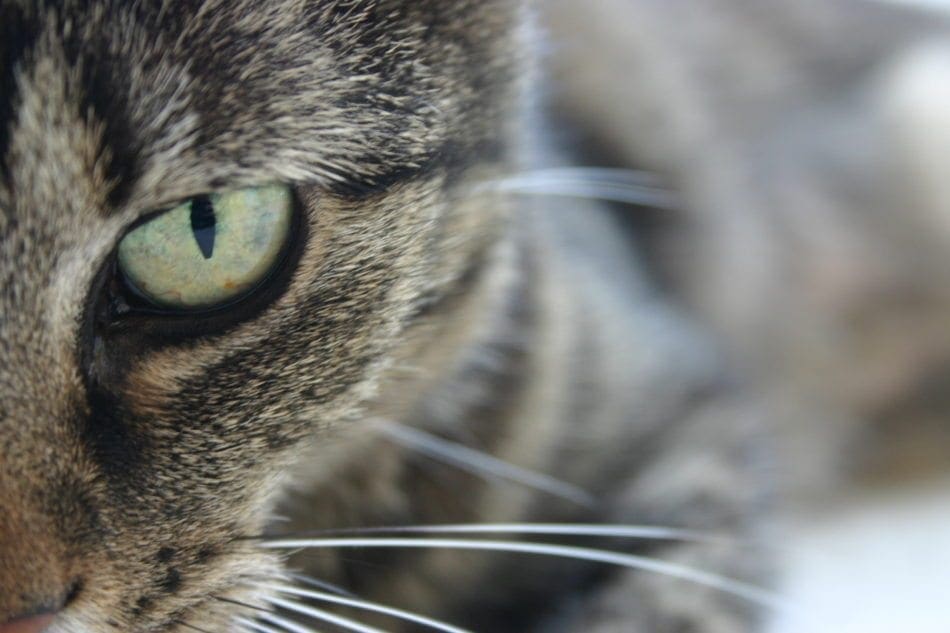
The eyes of a cat are not only beautiful and expressive, but they also have a unique way of perceiving the world around them. It’s important to note, however, that cats rely on more than just their vision to interact with their surroundings. When trying to interpret how cats navigate and perceive their surroundings, you must consider that vision works in harmony with their other senses: smell, touch, hearing, as well as their whiskers. So, as you admire those mesmerizing eyes, take a moment to also appreciate how a cat is a complex sensory processor packaged in a soft and furry exterior.
When examining how a cat’s vision compares to ours, there are some aspects that are similar, but there are also some notable differences. Do cats have better vision than us? I would say, it’s just different and suits them perfectly.
Can Cats See Color?
Many people mistakenly believe cats can’t see colors, but this isn’t entirely true. They do have the ability to perceive colors, but their range is more limited compared to us, resulting in muted color vision. Cats’ eyes possess fewer cones, which are responsible for color vision and are most effective in light conditions. Instead, their eyes contain a higher number of rods, which are the cells responsible for detecting movement and seeing in low light conditions. For a cat, being able to spot movement in dim light is far more essential than differentiating color. Initially, it was thought that cats only had two types of cones, but more recent information suggests they actually have three types, just as we do. The difference being that we have about ten times more cones than cats, so their perception of color is not as vibrant or true as that of humans.

Photo: Pam Johnson-Bennett
There is some disagreement about exactly what colors cats see. Most experts say gray, blue, and yellow. Cats have no cones for red. They may be able to see a bit of green, but they are basically red-green colorblind, similar to humans who are colorblind. So, what is your cat looking at when chasing the red laser toy? It’s the movement of the light and not the red color. (Side note: please stop using the laser light toy with your cat because it can cause frustration. The cat never gets to capture anything. It may also lead to an OCD-type behavior of chasing any flickering light.)
While cats have limitations in color vision, their exceptional ability to detect movement and their impressive low-light capabilities more than compensate for this. As natural hunters, they are well-equipped.
Field of Vision
Cats have a wider field of vision than we do. Cats have about a 200-degree total visual field, which includes about a 140-degree binocular field, compared to the 180-degree total field we possess. Their binocular visual field provides an advantage of excellent depth perception for movement detection and pinpoint accuracy when hunting prey.
Are Cats Nearsighted?
Cats are more nearsighted than us. Typically, we can see objects sharply at about 100-200 feet away. At that distance, the cat’s view of the image would be blurry. For the object to appear sharp the cat would need to be within about 20 feet of it.
How Well Can Cats See at Night?
People make the mistake of referring to cats as nocturnal, but they’re crepuscular. They are most active at dusk and at dawn, which is when their prey is most active. Like us, cats can’t see in total darkness, but they can see in such low light conditions that we would consider it totally dark. A cat’s vision is about six times better than ours in low light conditions, due to the large number of rod cells they have.
In addition to the rods, cats have a reflective layer of cells behind the retina called the tapetum lucidum. This special layer captures light that was not absorbed and reflects it back through the retina. The tapetum lucidum is what gives the eyes that “glow in the dark” effect when exposed to sudden bright light. By the way, cats aren’t the only animals who have the tapetum lucidum. Dogs, horses, cows, deer, ferrets, and some other animals have this feature as well to help them optimize vision in low light environments. Human eyes do not have this feature, as our eyesight is best adapted to daylight conditions.
Binocular Vision
As predators, cats have binocular vision, with eyes that are large for the size of their face. This allows for exceptional detection of movement and ambush accuracy. Despite their binocular vision, cats have difficulty seeing objects in very close-up range. To compensate for this, they depend on their sense of touch. When they capture prey in their paws, they rely on the carpal whiskers to detect positioning and movement of prey within their grasp. They also depend on their mystacial whiskers. Their excellent sense of smell is also called into play when something (such as a treat) is in very close range.
Pupils
We have round pupils that contract into small dots, whereas cats have elliptical pupils that contract to narrow vertical slits. The cat’s elliptical-shaped pupils can dilate or constrict much quicker than a human’s round pupils, allowing for a more rapid response to changes in light.
Depth Perception
Cats have excellent depth perception due to their binocular vision. Their large, forward-facing eyes sit on the front of the head, typical of a predator. This position aids in accurately judging distances.

Photo: Pam Johnson-Bennett
Third Eyelid
Cats have a third eyelid, called the nictitating membrane, that sits in a folded position in the inner corner of the eye. Its function is to provide protection and moisture by covering the eyeball when the cat walks through brush or branches. The nictitating membrane unfolds diagonally across the eye surface. The membrane is thin enough that when unfolded, the eyes still have visual ability while being protected from any debris. If you notice the nictitating membrane in the unfolded position for an extended period, it could indicate possible injury or illness and you should have your cat examined by the veterinarian.
Emotional State and Communication
In addition to the dilation and constriction of pupils due to lighting conditions, the cat’s pupils can also change size due to emotional state. Dilated pupils may indicate excitement or fear. The dilation is to allow maximum light into the eye for increased ability to detect movement. Constricted pupils, on the other hand may indicate agitation or an intent to display aggression. A direct stare can be viewed as a challenge, and an avoidance of eye contact may be a signal of a distance-increasing request. Slow, relaxed blinks are often interpreted as a sign of relaxation and feeling at ease with people or other cats nearby. Slow blinks are popularly referred to as cat kisses and many cat lovers often respond by returning a slow blink of their own. It’s important to note that you shouldn’t use pupil size by itself as an interpretation of what a cat is feeling. Identify other aspects of the cat’s posture as well as the current environment, including lighting conditions. Also keep in mind that a cat’s pupils may remain fixed despite lighting conditions because of illness or injury.
Caring for Your Cat’s Eyes
Do a regular check of your cat’s eyes. Look for signs of:
- discharge
- redness
- cloudiness
- excessive tearing
- squinting
- excessive pawing at the eye
- crustiness
- bulging
- swelling
- bleeding
- any sign of a scratch or other injury
- uneven or unusual pupil size
- keeping eye closed
- unusual blinking
- or anything else that appears unusual
If you notice any of the above signs, or anything else abnormal, have your cat examined by the veterinarian.
If you suspect something is wrong, don’t do an at-home diagnosis and don’t medicate on your own. Never put eye drops or other medication in your cat’s eyes unless you’ve been specifically instructed to by your cat’s veterinarian. Using the wrong medication can make an eye problem more serious. If your cat has had an eye problem in the past, don’t use any leftover medication because the medical issue may be completely different, and you could make the situation much worse. Eye problems can get serious very quickly so don’t hesitate in getting your cat to the veterinarian for a proper diagnosis and treatment.
With many cats, you won’t have to do much cleaning of the eye area but if you have a cat with a flatter face such as a Persian or Himalayan, you will most likely have to gently wipe the eyes due to excessive tearing. You may also have to do routine cleaning if your cat has a chronic eye issue. Your veterinarian will instruct you on what specific product to use. In many cases, a sterile saline solution is used, but your veterinarian will guide you. Before cleaning the eye area or administering medication, wash your hands first to prevent introducing bacteria to the delicate area. Be careful when wiping the eye that you don’t touch the eyeball as that will cause pain and potential injury. Use a very gentle touch. The area around the eye is very sensitive.
If you suspect there has been a change in your cat’s vision, consult your veterinarian immediately. Don’t assume declining vision is simply a normal part of aging. Loss of vision can be related to many things, including:
- Hypertension
- Hyperthyroidism
- Diabetes
- kidney disease
- Retinal detachment
- Cataracts
- Infection
- Trauma to the eye
Veterinary care is needed right away if you notice anything out of the ordinary, or if there’s a change in your cat’s behavior. Early intervention may save the cat’s vision and prevent needless suffering.
How will you know if your cat is going blind or having vision difficulty? There may be a change in the way he walks or stands, you may notice the cat bumping into things, or a reluctance to engage in typical activity. The cat may have trouble locating the litter box or feeding station. There may be a reluctance to jump or climb (although that can also be a sign of a mobility problem as well). Cats can experience vision problems just as humans can. Don’t delay in seeking veterinary care.
If your cat’s vision is declining and he has been an indoor/outdoor cat, it’s time to transition to indoor life. Cats with limited or no vision do very well navigating around the house but it’s important to not make furniture changes or create unexpected obstacles.
Need More Information?
If you have questions or concerns about the health of your cat’s eyes, or how to care for them, contact your veterinarian. This article is not intended to diagnose any medical problems nor is it dispensing medical advice. This article is for general information purposes only and is not to be viewed as a replacement for your cat’s individual veterinary care.
For information on cat behavior and training, refer to the books by Pam Johnson-Bennett. Pam’s books are available at bookstores and online. We have included Amazon links here on our website.


